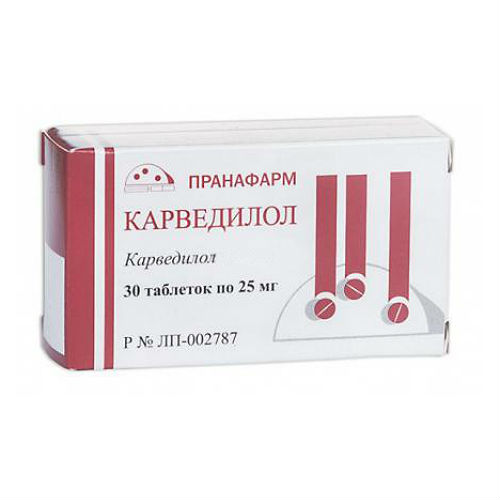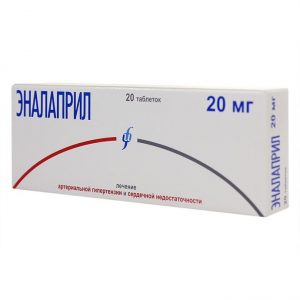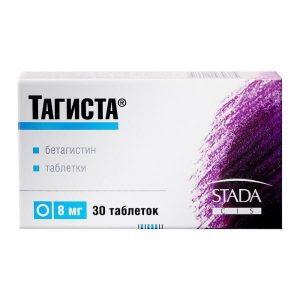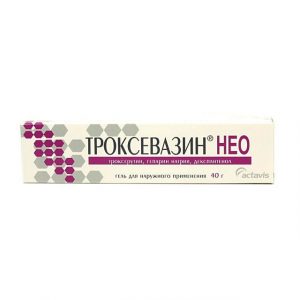Description
Pharmacological action
Carvedilol has a vasodilating, antianginal, antiarrhythmic effect. Blocks alpha1-, beta1- and beta2-adrenergic receptors. It does not have its own sympathomimetic activity, has membrane stabilizing properties. Carvedilol has an antioxidant effect, eliminating free oxygen radicals.
Indications
Arterial hypertension (monotherapy or in combination with other antihypertensive drugs), stable angina pectoris.
Contraindications
Hypersensitivity, chronic obstructive pulmonary disease, severe liver failure, severe bradycardia, sinus node weakness syndrome, AV block II and III degree (except for patients with a pacemaker), decompensated heart failure, pulmonary hypertension, cardiac hypertension, or cardiac hypertension , pregnancy, breast-feeding, under 18 years of age (safety and effectiveness in people under 18 years of age not established).
Recommendations for use
Carvedilol is taken orally, after a meal, with a small amount of liquid. The dose is selected individually. Arterial hypertension: the recommended dose in the first 7-14 days is 12.5 mg / day in the morning after breakfast or divided into 2 doses of 6.25 mg, then – 25 mg / day once in the morning or divided into 2 doses of 12.5 mg. After 14 days, the dose can be increased again. A Stable angina pectoris: the initial dose is 12.5 mg 2 times a day, after 7-14 days under the supervision of a doctor, the dose can be increased to 25 mg 2 times a day. After 14 days, with insufficient effectiveness and good tolerability of the drug, the dose can be further increased. The total daily dose should not exceed 100 mg (50 mg 2 times a day), over the age of 70 years – 50 mg / day (25 mg 2 times a day). When skipping the next dose, Carvedilol should be taken as soon as possible, however, if the time is approaching for the next dose, then only take it, without doubling. If it is necessary to cancel Carvedilol, the Obolensk dose reduction should be carried out gradually within 1-2 weeks.
Special instructions
In the case of a decrease in heart rate to 55 beats / min, the drug should be discontinued. In people with allergies or undergoing desensitization, taking carvedilol can increase allergy sensitivity. Persons using contact lenses should be warned that the drug reduces lacrimation. Upon completion of the treatment with Carvedilol, Sandoz simultaneously with clonidine first gradually reduces the dosage of clonidine and then first cancels clonidine, and then carvedilol. If necessary, the use of Carvedilol Sandoz during lactation, breastfeeding should be discontinued. During the treatment period, it is necessary to exclude the intake of alcohol. With the progression of circulatory failure during treatment, it is recommended to increase the dose of diuretics, in case of renal failure, a dose adjustment should be made taking into account the indicators of the functional state of the kidneys. If surgery is necessary using general anesthesia, the anesthesiologist should be warned about previous treatment with carvedilol. It should be borne in mind that the drug can mask the symptoms of thyrotoxicosis and hypoglycemia, therefore it is recommended to regularly monitor the level of glucose in the blood and, if necessary, adjust the doses.
Composition
1 tab. contains carvedilol 25 mg.
Side effects of
In recommended doses, Carvedilol is well tolerated, but in some cases, side effects are possible. From the digestive system: nausea, dry mouth, abdominal pain, diarrhea or constipation, vomiting, increased activity of hepatic transaminases. From the nervous system: headache, dizziness, feeling tired, loss of consciousness, muscle weakness (usually at the beginning of treatment), sleep disturbance, depression, paresthesia. On the part of the sensory organs: a decrease in tear production. From the genitourinary system: impaired renal function, edema, violation of urination. From the hemopoietic organs: leukopenia, thrombocytopenia. Allergic reactions: urticaria, itching, rashes, onset and / or exacerbation of psoriasis, sneezing, nasal congestion, bronchospasm, shortness of breath (in predisposed patients), very rarely – anaphylactoid reaction. From the CCC: bradycardia, orthostatic hypotension, angina pectoris, AV block, progression of circulatory failure (cold extremities), progression of heart failure, exacerbation of intermittent claudication syndrome, Raynaud’s syndrome. Endocrine Disorders: Weight gain. Other: limb pain, flu-like symptoms. As with other drugs that block alpha-adrenergic receptors, latent current diabetes mellitus may appear or its symptoms may intensify.
Overdose
Symptoms: marked decrease in blood pressure (SBP 80 mmHg or lower), severe bradycardia (less than 50 beats / min), respiratory failure (bronchospasm, etc.), chronic circulatory failure, cardiogenic shock, heart failure. Treatment: During the first two hours, induce vomiting and rinse the stomach. An overdose requires intensive treatment, monitoring of vital functions is necessary .. The patient should be in a position with raised legs, i.e. e. in the position of Trendelenburg. Beta-blocking antidotes are orciprenaline or isoprenaline 0.5 1 mg iv and / or glucagon in a dose of 1 5 mg (maximum dose 10 mg). Severe hypotension is treated with parenteral administration of fluid and repeated administration of adrenaline at a dose of 5-10 mg (or its intravenous infusion at a rate of 5 μg / min). With excessive bradycardia, iv atropine is prescribed at a dose of 0.5 2 mg. To maintain cardiac activity: intravenously (within 30 s) glucagon is administered, followed by continuous infusion at a rate of 2 5 mg / h. If the peripheral vasodilating effect predominates (warm limbs, in addition to significant arterial hypotension), it is necessary to prescribe norepinephrine at 5 10 μg in the form of an iv infusion – 5 μg / min. For relief of bronchospasm, beta-adrenergic agonists are prescribed (in the form of an aerosol or iv) or aminophylline iv. If convulsions develop, slow administration of diazepam or clonazepam is recommended. In severe cases of intoxication, when the symptoms of shock dominate, treatment should continue until the patient’s condition stabilizes, taking into account T1 / 2 carvedilol of 6 10 hours.
Storage conditions
At a temperature not exceeding 25 ° C. Keep out of the reach of children.
Expiration
3 years.
Deystvuyuschee substances
Carvedilol
Pharmacy Conditions
prescription
dosage form
tablets




